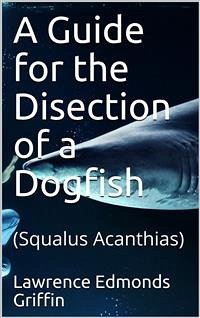The small sharks which abound along the coasts of the United States are commonly called “dogfish” by fishermen and others. The “dogfish” of inland waters belongs to an entirely different group. Two species of sharks are caught in numbers and used in laboratory work, the “spiny dogfish” (Squalus acanthias) and the “smooth dogfish” (Eugaleus galeus). The first is easily distinguished by the sharp spine in front of each dorsal fin. Squalus acanthias is often referred to under the synonym Acanthias vulgaris, while Eugaleus galeus is more frequently named either Mustelus canis or Galeus canis. The histories of these names and systematic descriptions of the species are contained in Samuel Garman’s Monograph on the Elasmobranchs.
Several sizes of dogfish are furnished by dealers. We consider it best to purchase large, fully developed specimens. The small specimens may be a little more convenient to handle, but the large ones have the important advantage of being sexually mature, while blood vessels and nerves are dissected better in large than in small specimens. Also, a number of structures are very different in mature animals from their condition in young ones. Dealers should be requested to furnish fish with fins and tails complete instead of trimmed. It is an advantage to issue to the class equal numbers of both sexes.
An entire specimen and an extra head may be required by each student for a thorough dissection. It would be better if the head were cut off just behind the pectoral fins, instead of in front of them as is usually done, so that the vagus and hypobranchial nerves may be dissected more completely.
The spiny dogfish, which is the particular subject of this guide, is the species most frequently supplied to laboratories. However, the spiny and smooth dogfishes are so much alike that the latter may be easily dissected with these directions. Where marked differences between the forms exist the structure of Eugaleus is described separately.
The student of anatomy should realize that dissection is for the purpose of enabling him to see for himself the structures which exist, and that no dissection is satisfactory until the anatomical arrangements mentioned in the text can be completely demonstrated in his specimen.
The importance of knowing the structure of the elasmobranch is so great in comparative anatomy and embryology that it is worth while to make a thorough dissection of one of this class. As the dogfish is frequently the first major vertebrate form to be studied in detail, these directions have been written to conform to the needs of the student who is beginning comparative anatomy. The arrangement of sections in this guide is intended to permit the omission of some which it may not be considered desirable to include in the work of a class.
Several sizes of dogfish are furnished by dealers. We consider it best to purchase large, fully developed specimens. The small specimens may be a little more convenient to handle, but the large ones have the important advantage of being sexually mature, while blood vessels and nerves are dissected better in large than in small specimens. Also, a number of structures are very different in mature animals from their condition in young ones. Dealers should be requested to furnish fish with fins and tails complete instead of trimmed. It is an advantage to issue to the class equal numbers of both sexes.
An entire specimen and an extra head may be required by each student for a thorough dissection. It would be better if the head were cut off just behind the pectoral fins, instead of in front of them as is usually done, so that the vagus and hypobranchial nerves may be dissected more completely.
The spiny dogfish, which is the particular subject of this guide, is the species most frequently supplied to laboratories. However, the spiny and smooth dogfishes are so much alike that the latter may be easily dissected with these directions. Where marked differences between the forms exist the structure of Eugaleus is described separately.
The student of anatomy should realize that dissection is for the purpose of enabling him to see for himself the structures which exist, and that no dissection is satisfactory until the anatomical arrangements mentioned in the text can be completely demonstrated in his specimen.
The importance of knowing the structure of the elasmobranch is so great in comparative anatomy and embryology that it is worth while to make a thorough dissection of one of this class. As the dogfish is frequently the first major vertebrate form to be studied in detail, these directions have been written to conform to the needs of the student who is beginning comparative anatomy. The arrangement of sections in this guide is intended to permit the omission of some which it may not be considered desirable to include in the work of a class.









